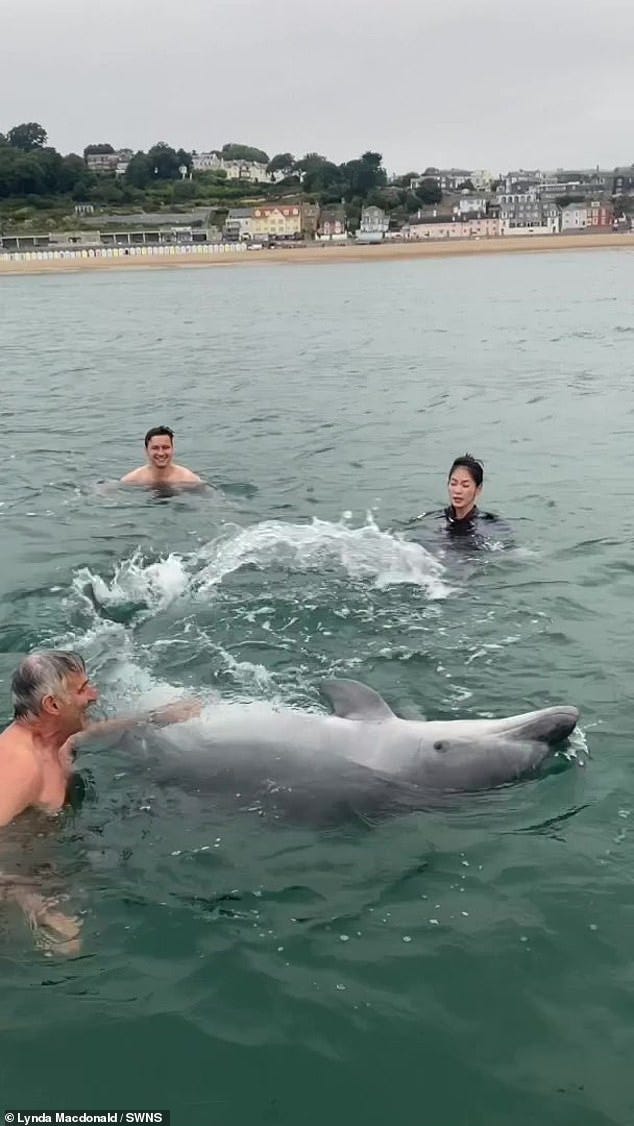There’s a young male bottlenose dolphin named Reggie who has been hanging around Lyme Bay in the UK, which is great news for tourism, but terrible news for Reggie. He’s what scientists call a lone sociable dolphin (or solitary-sociable cetacean); a term that describes a dolphin that is rarely or never seen in the vicinity of other dolphins, and typically hangs out close to shore near humans. There have been hundreds of cases of dolphins like these (typically males) across the planet over the years (almost always bottlenose dolphins) including Fungie in Ireland, Moko in New Zealand, and Dave in Kent.
Nobody is sure why these dolphins leave their normal groups and hang around humans. But part of their public appeal is that, in some cases, they appear to seek out the company of humans, even allowing humans to touch and grab onto them. This is fantastically bizarre behavior for a wild dolphin, which makes these lone sociables a curiosity for scientists.
Scientists studying lone sociable are adamant that humans need to steer clear of these little weirdos. Too much human attention will ultimately result in their deaths. For example Dave, like many lone sociables, was likely killed by a propellor strike after getting too close to a boat.
Now I am generally not opposed to anthropomorphizing animals, as I make clear in my new book. But it’s precisely cases like these that reveal the dangers of assuming animals have human-like thoughts and intentions. In the case of Reggie, headlines declared that he was “asking for belly rubs” while swimming with humans. As Liz Sandeman, co-founder of Marine Connections (an org that studies lone sociable dolphins) explained quite succinctly to The Guardian: “He’s not asking for belly rubs.”
Indeed. To the casual observer, it looks like Reggie has flipped upside down to solicit belly rubs. But that’s not a thing dolphins typically want from either humans or other dolphins. And in this video of Reggie exposing his belly, some dude reaches out and smacks Reggie’s genital slit instead of his belly (around the 45 second mark). Now even though I study dolphin behavior for a living, I can’t possibly say for sure what a dolphin is really thinking. But I can say with some certainty that no dolphin wants to get smacked in the genital slit (i.e., the hole from which very sensitive genitals emerge when required). Reggie is definitely not asking for that!
In many cases where we are guessing wrong as to an animal’s true intentions via anthropomorphism, there is no harm done. We might think our cat is jealous when really they’re just tired or angry. But in some cases, as in the case of lone sociable dolphins, incorrectly guessing their intentions means we might see “friendly” behavior when there is in fact indifference, aggression, or simply hunger. And even if their true intentions might fit the category of “friendly” sometimes, it’s still important that we don’t interact with them in the same way we would with another human. Anthropomorphizing lone sociable dolphins is simply too dangerous. As Sonja Eisfeld-Pierantoni of Whale and Dolphin Conservation told The Guardian:
Although solitary, Reggie is still a wild animal and should be treated as such, not as an opportunity to interact with. These dolphins stop behaving like wild animals, because of humans insisting to interact with them. They might stop feeding naturally, take more risks, and get too close to dangerous situations. Sadly, most solitary sociable dolphins don’t survive long once fully habituated.
All this to say that while anthropomorphism is both common and generally a force for good, it’s cases like these where we need to take a step back and realize that animals’ thoughts, feelings, and intentions do not often map directly onto the human experience. We must be mindful of the diversity of other minds lest we end up harming the animals we love.
Speaking of anthropomorphism, here is an unconventional unboxing video I made after receiving copies of my new book Humanish.




